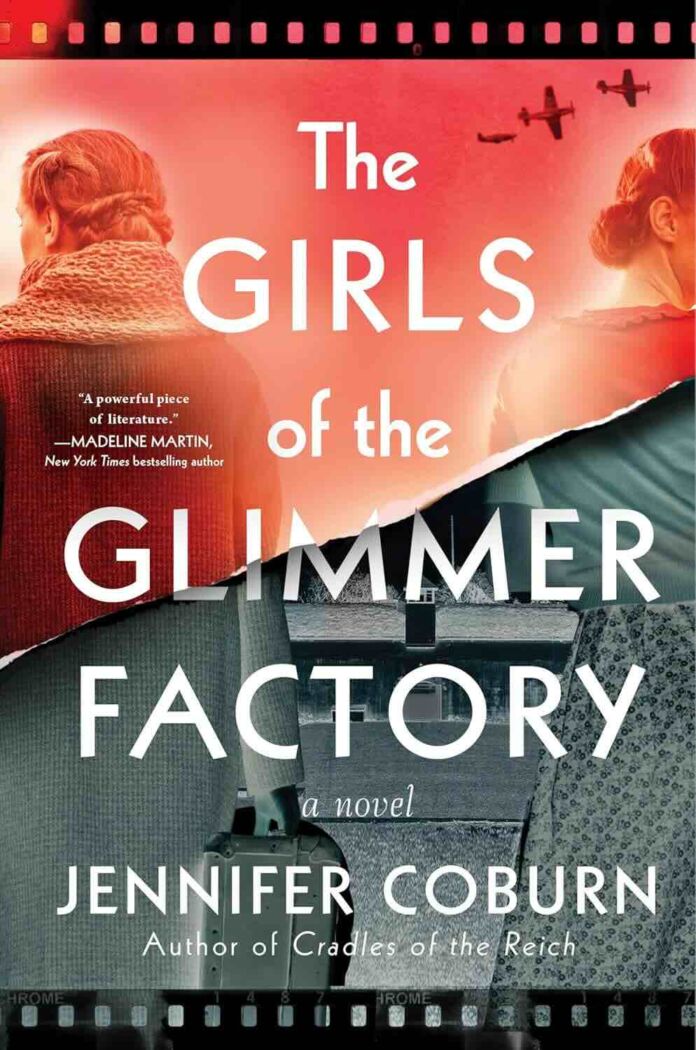Jennifer Coburn’s The Girls of the Glimmer Factory is a profound exploration of courage, identity, and the devastating impact of propaganda during World War II. With a narrative grounded in the historical reality of Theresienstadt—a Nazi-created “model” ghetto—Coburn masterfully weaves a tale of two women on opposing sides of history. For fans of Kristin Harmel’s The Forest of Vanishing Stars and Kelly Rimmer’s The German Wife, this book offers a fresh perspective on the complexities of survival, truth, and friendship amidst the horrors of the Holocaust.
Plot Overview
The story unfolds through the dual perspectives of Hannah, a Jewish prisoner in Theresienstadt, and Hilde, a devout believer in the Nazi regime. Theresienstadt, a “model” ghetto, serves as a chilling facade for the Nazi propaganda film Hitler Gives a City to the Jews. While the world is meant to believe in the humane treatment of Jews, the reality is far bleaker. Hannah, a young resistance member, is determined to expose the truth, even as she faces the terror of deportations to death camps.
On the flip side, Hilde works for the Reich Ministry of Enlightenment and Propaganda. Her unwavering faith in the Nazi cause is tested when she is sent to Theresienstadt to ensure the film’s success. When Hilde recognizes Hannah as her childhood friend, her loyalties are challenged, setting the stage for a heart-pounding narrative where deception and truth are in constant battle.
Coburn doesn’t shy away from the harsh realities of the era. The stark contrast between the idyllic scenes manufactured for the camera and the suffering endured behind the facade is a testament to her meticulous research and storytelling prowess.
Character Analysis
Hannah: The Voice of Resistance
Hannah is the heart of the story. Her quiet resilience and bravery shine as she navigates the treacherous waters of life in Theresienstadt. Through her, Coburn highlights the indomitable spirit of the many who resisted the Nazi regime from within. Her interactions with fellow prisoners, her secretive efforts to thwart propaganda, and her inner turmoil bring an authentic voice to the narrative.
Hilde: The True Believer
Hilde’s character is equally compelling but in a hauntingly different way. Her journey from blind faith in the Nazi ideology to the slow erosion of that belief is portrayed with nuance. Coburn avoids easy villainization, instead offering a complex portrait of how ordinary individuals could be swept into extraordinary atrocities. Hilde’s recognition of Hannah forces her to confront her own morality, leading to a transformation that feels both earned and tragic.
Writing Style and Tone
Jennifer Coburn employs a literary yet accessible style that enhances the historical weight of the story. The alternating perspectives are balanced and allow the reader to immerse themselves fully in the lives of both protagonists. Her descriptive prose paints vivid images of the setting—from the deceptively cheerful facades of the ghetto to the chilling halls of the Reich’s propaganda offices.
Coburn’s use of historical detail is commendable. The reader is not only transported to 1940s Europe but also educated about the lesser-known aspects of Nazi propaganda. The meticulous depiction of Theresienstadt, the grim realities of Operation Embellishment, and the dangerous game of deception played by the Nazi film crew enrich the narrative.
Themes Explored
The Power of Propaganda
One of the most striking themes is the terrifying efficiency of Nazi propaganda. Coburn sheds light on how lies can reshape reality not only for those watching from afar but also for those caught within the web of deceit. Hilde’s storyline is a sobering reminder of the dangers of blind faith in a regime.
Resistance in Small Acts
The novel also celebrates the power of resistance. Hannah’s bravery is not only in grand gestures but in the small, everyday acts of defiance—whether it is sharing a secret loaf of bread or subtly sabotaging the Nazi film. The novel beautifully portrays how hope can be an act of rebellion.
Friendship and Betrayal
The complex relationship between Hannah and Hilde adds emotional depth to the story. Their shared childhood is a fragile thread that connects them even as the world around them crumbles. The evolution of their relationship—from recognition to manipulation and, ultimately, to a fractured understanding—is one of the novel’s strongest aspects.
Critique: Where the Novel Could Improve
While The Girls of the Glimmer Factory is an impressive novel, it is not without its flaws. At times, Hilde’s transition from a fervent Nazi supporter to a conflicted observer feels somewhat rushed. A deeper exploration of her internal conflict, particularly through more reflective passages, could have added layers to her character arc.
Additionally, while Coburn’s attention to historical detail is commendable, there are moments where the exposition feels heavy-handed. Certain historical explanations, while valuable, occasionally disrupt the otherwise smooth narrative flow.
Final Thoughts
The Girls of the Glimmer Factory is a powerful addition to the canon of World War II historical fiction. Jennifer Coburn delivers a narrative that is both heartbreaking and inspiring, balancing the darkness of the era with the light of human resilience. It is a story that challenges the reader to confront uncomfortable truths about the past and consider the echoes of those truths in today’s world.
This novel is highly recommended for readers who appreciate historical fiction that is rich with research, strong in character development, and fearless in its exploration of difficult topics. It stands alongside works like The Nightingale by Kristin Hannah and Lilac Girls by Martha Hall Kelly, offering a fresh perspective on a well-trodden subject.
Recommended Reads
If you enjoyed The Girls of the Glimmer Factory, you might also like:
- The Forest of Vanishing Stars by Kristin Harmel
- The German Wife by Kelly Rimmer
- The Nightingale by Kristin Hannah
- Lilac Girls by Martha Hall Kelly
- Cradles of the Reich by Jennifer Coburn
- The Alice Network by Kate Quinn
- The Book Thief by Markus Zusak
The Girls of the Glimmer Factory is a book that will linger in your thoughts long after you turn the last page, reminding you of the strength of the human spirit and the enduring necessity of truth.





